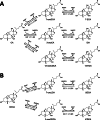Review: microbial transformations of human bile acids
- PMID: 34127070
- PMCID: PMC8204491
- DOI: 10.1186/s40168-021-01101-1
Review: microbial transformations of human bile acids
Abstract
Bile acids play key roles in gut metabolism, cell signaling, and microbiome composition. While the liver is responsible for the production of primary bile acids, microbes in the gut modify these compounds into myriad forms that greatly increase their diversity and biological function. Since the early 1960s, microbes have been known to transform human bile acids in four distinct ways: deconjugation of the amino acids glycine or taurine, and dehydroxylation, dehydrogenation, and epimerization of the cholesterol core. Alterations in the chemistry of these secondary bile acids have been linked to several diseases, such as cirrhosis, inflammatory bowel disease, and cancer. In addition to the previously known transformations, a recent study has shown that members of our gut microbiota are also able to conjugate amino acids to bile acids, representing a new set of "microbially conjugated bile acids." This new finding greatly influences the diversity of bile acids in the mammalian gut, but the effects on host physiology and microbial dynamics are mostly unknown. This review focuses on recent discoveries investigating microbial mechanisms of human bile acids and explores the chemical diversity that may exist in bile acid structures in light of the new discovery of microbial conjugations. Video Abstract.
Keywords: Bile acid; Cholic acid; Clostridium scindens; Conjugation; Enterocloster bolteae; Gut health; Metabolism; Microbiology; Microbiome.
Conflict of interest statement
The authors declare that they have no competing interests.
Figures





References
Publication types
MeSH terms
Substances
LinkOut - more resources
Full Text Sources
Other Literature Sources
Medical

